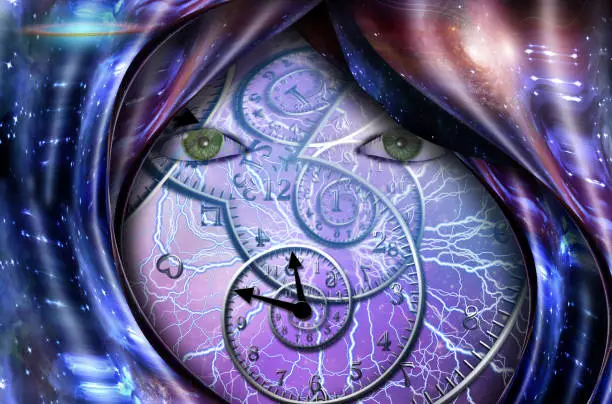A fascinating article by authors Emily Qureshi Hurst and Anna Pearson (a physicist and philosopher, respectively) explores the implications of “indefinite causal order” of events (basically the absence of sequential order in time), entailed by both Einstein’ theory of relativity and quantum physics, for 1) the nature of physical time itself and 2) the nature and possibility of personal salvation in religion. It argues that both relativity theory and quantum physics undermine completely the “A-series” concept of time (the classical assumption underwriting Newtonian physics that there is a definite absolute past, present, and future in time, time flows independently of the events and objects within it, and that only the present moment exists) and only accommodate the “B-Series” concept of time (the post-Newtonian idea that there is no independent momentary past-present-future that exists independently of any events occurring within it – there are only sequential relations between interrelated events) to the extent that the “block universe“ theory (which states that time does not exist at all and that every event in the history of the entire universe exists simultaneously) is true. According to Newtonian physics, there is an absolute flow of time in the physical universe whereby a particular present moment in time is simultaneous for every event at that time. However, in both relativity theory and quantum physics, indefinite causal order undermines the idea of simultaneity and of a single universal absolute time for the entire universe. Both Einsteinian and quantum “relativity theories” they write,
“have contributed substantially to the demise of the A-theory by disposing with the idea of absolute simultaneity. We believe Indefinite Causal Order is the final nail in the A-theory’s coffin. What is left must be some form of a block universe. Within this temporal ontology concepts as basic as change—and those moral theories and theological doctrines involving change—must be revisited.”
In the block universe (to which Einstein and others subscribed), our sense of time arises when, from a limited localized vantage-point, we subjectively view the universe as a sequence of changing events, although for the objective universe as a whole, these events exist statically and simultaneously. (Analogous to a person traveling through a mountain range on train subjectively experiencing each mountain as coming-and-going in sequential succession, although objectively all the mountains in the range exist simultaneously without any sequence).
The contrast between a radically time-bound quasi-Newtonian universe on one hand, versus a block universe predicated on developments in relativity theory and relational physics on the other hand, is exemplified by theories found respectively in books like Unger and Smolin’s The Singular Universe and the Reality of Time (which posits time — a linear sequential causal order – as foundational to reality) and Silberstein’s, Stucky’s and McDevitt’s Beyond the Dynamical Universe: Unifying Block Universe Physics and Time as Experienced (which posits a timeless block universe as foundational to reality, and time-bound sequential order as a derivative, emergent phenomenon).
The article argues that both relativity theory and the concept of non-locality in quantum physics involve concepts of space and time that undermine or eliminate completely the Newtonian (and post-Newtonian) concept of time as a sequential succession of past-present-future events. Instead, these theories involve (or at least strongly imply) the reality of a block universe in which sequential time does not exist objectively. Three consequences of this are that 1) no objective change occurs in the universe, 2) our decisions and actions are determined in advance of our making them, since every event already objectively exists and therefore 3) free will in the conventional sense does not exist. Since spiritual salvation in Abrahamic (Judeo-Christian-Islamic) religious belief systems requires the subject’s soul changing through time to attain spiritual regeneration or communion with God, etc., and this process requires genuine change in an individual’s life, as well as the freedom to choose this life, it would appear that spiritual salvation, as it is conventionally understood in these religions, would be impossible.
However, the article goes on to argue that, although the conditions described above would indeed disallow salvation via personal transformation from the standpoint of the objectively timeless and static block universe (like the objectively existing mountain range), personal transformation is still possible from the subjective vantagepoint of the spaciotemporal (time bound) individual, moving through and interacting with a dynamic sequentially unfolding reality (like the traveler through the mountain range). Ontologically distinct from the objective universe, which is bound by timeless physical laws, the localized limited vantagepoint of subjective consciousness permits time, change, and free will to emerge in the otherwise objectively timeless block universe, enabling individuals to make free choices by which they can transform themselves and attain spiritual salvation.
This is certainly a sound argument and interesting vantage-point from which to reconcile the physics of time and cosmology with the conventional Christian theological necessity for free will. However, here is where the article’s argument —wide-ranging and profound as it certainly is—may not do justice to the full purview of either science or religion themselves: Hearst and Pearson propose an ontological dualism between religion and science– a metaphysical dichotomy which then requires complex metaphysical stratagems to reconcile. First, they contend that:
“science provides the most reliable, empirical knowledge of the physical world. Hence, “the proper object of most metaphysics is the careful analysis of our best scientific theories….” [Maudlin, 2007] Robust temporal ontologies must be rooted in contemporary scientific data, even if that scientific data is speculative or incomplete.”
This claim, contrary to Hearst’s and Pearson’s intent, sounds at least vaguely scientistic, giving science a metaphysically-ontologically, superior (or at least metaphysically prior) status relative to all other metaphysical claims, including religious conceptions. Further, even if science provides the most reliable empirical knowledge of the physical world, the authors don’t explain why it follows that metaphysical-ontological phenomena –time, or anything else—is best described by or rooted in scientific theories, since metaphysics-ontology falls outside the physical purview of physics by definition. However, they then qualify this idea with the further, seemingly contradictory, claim that:
“Although this may hold initial appeal to opponents of religion, there are good reasons for rejecting it…. it dismisses the core beliefs of many systems that are theologically or spiritually committed to doctrines that require ontological change. Science is not in the business of refuting religion. …If salvation is a matter of theological importance, then science should not be trying to refute it.”
This further claim would seem untenable if, as they first assert, “the proper object of most metaphysics is the careful analysis of our best scientific theories” and “ontologies must be rooted in contemporary scientific data.” Wouldn’t the obligation of metaphysics conforming to, or being ‘rooted in’, ‘scientific data’ , mean that science IS in the business of refuting religious claims, since religious claims must conform to metaphysical standards set by science, in order to be legitimate?
These two irreconcilable conditions — 1) the apparent metaphysical-ontological priority of scientific metaphysics over religious metaphysics and 2) the apparent independence of religious claims from scientific rebuke — seem to commit the authors to a similarly irreconcilable dualism. They want to the liberate experienced temporality, the soul, freewill, and God from the scientifically determined physical world, while still reconceiving these nonphysical phenomena within the parameters set by physics. The timeless and determined block universe is accorded primary metaphysical status as an objective physical foundation establishing the conditions under which the subjective cosmic drama of soul, free-will, salvation, and time can take place. However, the authors also want to grant these spiritual phenomena a standing that remains independent from the physical universe –as unconditioned by the physical laws to which they are also supposedly subject.
The coherence problems posed by this kind of religion/science dualism mirrors similar and related dualisms in western philosophy: mind/body dualism, free-will/determinist dualism, super-naturalist/naturalist dualism, etc.. All of these share a common historical legacy in western civilization—originating with the sundering of God from humanity and heaven from earth in western thought, leaving humanity alienated from its ultimate source. This original dualism also left the soul alienated from its earthly, bodily, container (mind separate from the body), personal volition or will alienated from the very mind through which it emerges (conscious free will separate from the determined physical world), space and time separate from the cosmic intelligence that conceived them (spirituality separate from science). However, despite the myriad and ongoing attempts to reconcile these divisions throughout western intellectual history, such explanations have always fallen short. Not only have dualistic metaphysical categories defied rapprochement, they have also defied basic intelligibility as legitimate categories in themselves.
As a result, just like the physical/theological dualism Hearst and Pearson attempt to resolve with a new interpretation of physics, increasingly intricate arguments continue to advance these other dualist oppositions further, step-by-step, without any final resolution. Even the currently fashionable “physicalist” worldview, –which attempts to resolve the logical inconsistencies in dualist metaphysics by simply erasing one aspect of it (the spiritual soul, free will, and God aspects) and acknowledging only the determined, disenchanted, physical world—is undermined by its own logical inconsistencies and empirical inadequacies.
Although there has always been a persistent but uncelebrated “idealist” minority report running parallel to both dualist and physicalist metaphysics (Idealism holding that all reality is only mental or cosmic consciousness: Platonic and Vedanta philosophies being ancient versions, Shani’s version of “cosmopsychism”, Albihari’s “Analytic Buddhism”, and Kastrup’s “Analytic Idealism”, being some of the most recent examples) scientific physicalism has still been overwhelmingly predominant in western philosophy and science for several centuries. However many Asian, African and meso-American traditions have always advocated, in various forms, a non-physicalist, mind-centered alternative –refusing to sunder the spiritual, super-natural, volitional and time-bound dimensions of existence from its physical, natural, determined, abstract and timeless dimensions, in the first place. This alternative encompasses Hearst’s and Pearson’s dual worlds –scientific and religious—and acknowledges their separateness, however it envisions reality’s dualistic aspects as just two dimensions of a larger, holistic reality. It regards spirituality and science as opposite sides of the same coin—both aspects of a single reality that ultimately transcends them both. This transcendent reality could be the eternal God of Abrahamic theology or the final ‘theory of everything’ sought by science… But it would also, in a sense, transcend even these– being greater than any religious or scientific concept or theory could ever do justice to. Encompassing classical physics, relativity theory, quantum mechanics, Newtonian space and time, Einstein’s spacetime, quantum theory’s indefinite causal order, a Block universe, a time-bound universe, and infinitely more, such a holistic unity would heal the dualistic metaphysical dichotomy that divided time and eternity at the very dawn of our modern speculations about reality.
We hope you enjoy our articles. Please note, we may collect a share of sales or other compensation from the links on this page. Thank you if you use our links, we really appreciate it!



